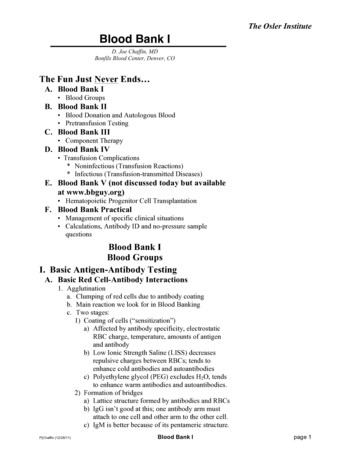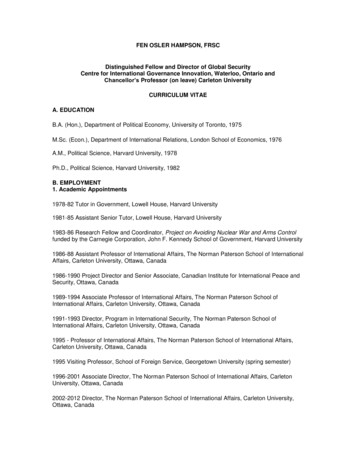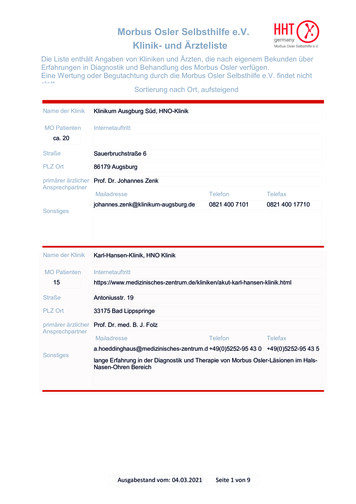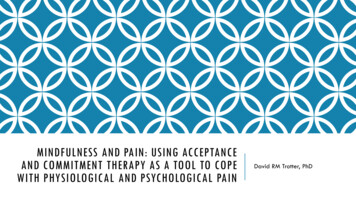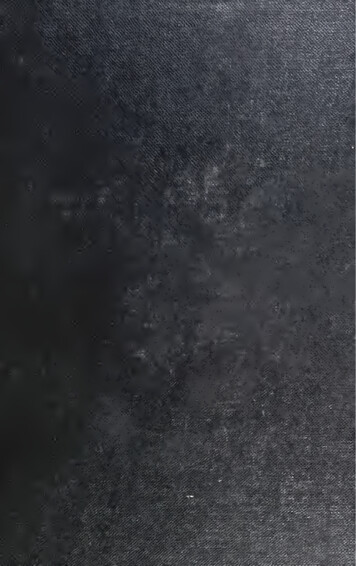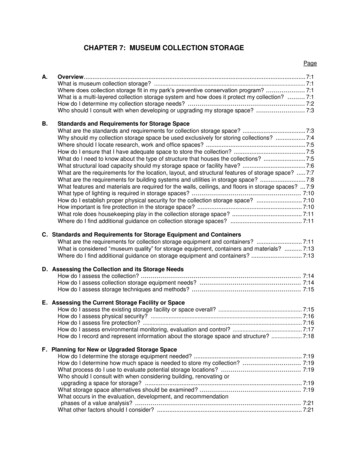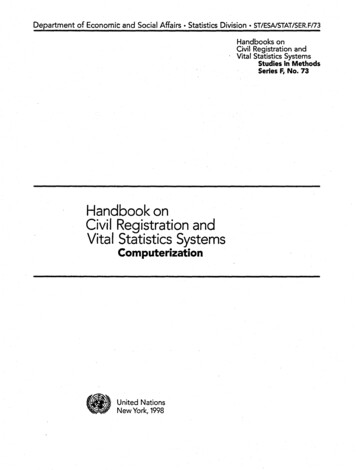
Transcription
Medical History, 1997, 41: 213-225Illustrations from the Wellcome Institute LibraryWellcome and OslerJOHN SYMONS*The lives of Sir William Osler (1849-1919) and Sir Henry Wellcome (1853-1936) havemuch in common: they were nearly coevals; both were natives of North America whoended their lives in England; both devoted their lives to medicine and achieved publichonours; both are commemorated in a variety of eponymous institutions; moreimportantly for present purposes, both pursued the study of medical history and formedlibraries which now bear their names. It would be unwise to push any of these parallelstoo far, but the common interest in medical history and book collecting does raise thequestion of what actual contact there was between the two. Older habitu6s of theWellcome Institute will remember that from 1966 to 1973 the Institute's Seminar Roomon the second floor of the Wellcome Building (approximately on the site of the presentWellcome Trust Boardroom) carried the joint dedication of 'The Wellcome-Osler Room'(in practice always shortened to 'The Osler Room'), which suggested some positiveconnection. In fact it seems to have been the personal inspiration of Dr Noel Poynter(1908-1979), former Librarian and Director, and did not long survive his retirement,though the name could occasionally be heard until the end of the 1980s, when the roomceased to exist.Surviving papers in the Wellcome Institute Archives show that direct contact betweenWellcome and Osler was minimal. However, Osler did have a cordial relationship with theWellcome Historical Medical Museum and with its first Curator, C J S Thompson(1862-1943). The correspondence between them shows that the Wellcome Museum in itsearly days was more outgoing than is usually realized. Folk-memory derives largely fromthe experiences of those who knew the Museum in the 1920s and 1930s, when Wellcomeimposed a much more secretive regime culminating in 1932 in a total closure of theMuseum, from which it did not emerge until 1949. The memory of Thompson's moreaccessible policy has thus been largely eclipsed. It was possibly not entirely to Wellcome'sliking and seems to have been one of the factors contributing to the severance of relationsbetween him and Thompson in November 1925.*John Symons, MA, ALA, Curator, Early PrintedBooks, Wellcome Institute for the History ofMedicine, 183 Euston Road, London NW1 2BE.I am most grateful to June Schachter, Osler Library,McGill University, Montreal, for providingphotocopies of letters under her care and forpermission to quote from them, also to LindaGriffiths, Royal Society of Medicine, and JenniferHaynes at the Wellcome Institute for access toarchival 396 Published online by Cambridge University Press
John SymonsOsler settled in England in 1905 on appointment as Regius Professor of Medicine atOxford. His first appearance in the Wellcome Archives is in 1907, in the role of a rivalcollector. It is unlikely that their professional paths had crossed before then. Mr Wellcomethe pharmaceutical manufacturer (or less politely "Wellcome the pill man") moved indifferent circles from the leaders of the medical profession. He was not yet "Founder andDirector of the Wellcome Historical Museum", still less "Sir Henry Wellcome, Kt., LL.D.,D.Sc., F.R.S., Hon. F.R.C.S."1 Thompson reported as follows on his dealings with thecharismatic book dealer Wilfrid Michael Voynich (1865-1930):I finally got him down to twenty-seven pounds. I found that it was necessary to close with him atonce, as he was writing to Professors Fergusson [sic], Osler and others offering the work on anatomyand the early surgicals so . I decided to take them, as although the prices of some were rather stiff,I thought that on the whole they were not dear. I shall be glad to know if you approve of this.2Exactly two years later, he reported in similar terms:He said he must have an early decision as he knew he would have no difficulty in disposing of theMSS. especially, to Professor Osler and Professor Ferguson. The former has given him an opencommission for all MSS. he can get on medicine, surgery and anatomy but, as he said, he had keptto his word and given me the first chance, being his oldest customer.3Both these reports suffer from the loss of Voynich's idiosyncratic English, as laterrecorded by his assistant Millicent Sowerby:He spoke eighteen languages, all, so he told us, equally badly . . . "Mees Johnson is?" he would askas he entered the shop . . . "No," we would tell him, "she has gone to lunch". "Oh, did she went?"would be Mr Voynich's invariable comment.4Curiously, although Voynich could claim Osler as a regular customer, they had not yetactually met, and this was still true even as late as 1913 when the newly joined MissSowerby provoked a tantrum by unwittingly failing to inform her employer that Osler wasin the shop:"Mees Sowerby, you have done unpardonable thing! What I can think? What I can do? What I cansay? My God! What staff I have!! !" Then with a big sigh, "O ma mie, Madonna Sanctissima!!!"5Wellcome always maintained an obsessive secrecy about his collecting activities butearly in 1910 the imminence of the 17th International Congress of Medicine, scheduledfor 1913, forced him to begin to break cover. On 18 February 1910 Thompson wrote: "Itwould be well if we made as soon as possible the announcement that the HME [HistoricalMedical Exhibition] will be held at that time, to prevent the Committee [of theIntemational Congress] competing with us."6 Wellcome, who was then at Quito, Ecuador(where, incidentally, he had fatefully quarrelled with his wife Syrie), scribbled back on 271 Letters written by Sir John MacAlister(1856-1925), Secretary of the Royal Society ofMedicine, in support of Wellcome's candidacy forthe Athenaeum in 1924 confirm the prejudice againsttrade. (RSM Archives G28/Box 37.)2 Wellcome Institute Archives. ThompsonReports 18 January 1907. Professor "Fergusson" isJohn Ferguson (1837-1916) of Glasgow.3 Wellcome Institute Archives. ThompsonReports 18 January 1909.4 E Millicent Sowerby, Rare people and rarebooks, London, Constable, 1967, p. 7.5 Ibid., p. 16.6 Wellcome Institute Archives. ThompsonReports 18 February 1910.214https://doi.org/10.1017/S0025727300062396 Published online by Cambridge University Press
Wellcome and OslerMarch: "Give a Syllabus. Inform the Committee the date of the HM Exn and ask their co-operation."7Henceforward it was inevitable that word of Wellcome's plans for his Museum wouldbegin to circulate among the medical profession, though it is not clear when it reachedOsler's ears. It was in the following year, 1911, that their paths most memorably crossed.The main portion of the library of Dr Joseph Frank Payne (1840-1910), HarveianLibrarian of the Royal College of Physicians and a leading medical historian, was to besold at Sotheby's on 12-14 July 1911. It was to be offered first as a single lot and Oslerwas keen to secure it for Johns Hopkins. He had 2,000 guaranteed by W A Marburg ofBaltimore. The Wellcome archives are silent on the subject (as usual when Wellcome wason the spot and able to conduct his business personally) bui Osler's account is famous:The executors had placed a reserve price of 2,700, but on the morning of the sale I received anintimation that it would be reduced to 2,500 . With Dr Henry Barton Jacobs and Dr George Dock,I went to Sotheby's at one o'clock on July 12th. A more rapid sale I never saw! The bidding beganat 2,000 [sic], and within a minute it was knocked down to an unknown bidder at 2,300, a figurebeyond that which Mr Marburg had mentioned, but Dr Jacobs and I were prepared to go to thereserve price had we had a chance! The name of the purchaser is not known, but I believe thecollection remains in this country.8A handwritten note in the Osler Library at McGill supplies additional details (Osler'serroneous figures are corrected by the Osler Librarian, W W Francis):The Library was put up en bloc. Quaritch was bidding for us. It started at 2,000 [1,000], went up to2,500 [1,500], and then 3,000 [2,000], and before I could consult with Q. it was knocked down at 3,300 (or 500) I forget which [2,300] . I would have gone to 3,500 [2,500] as it would have beeneasy to make up the balance from the sale of duplicates.9Wellcome's agent, who gave his name as Tobin, still resists identification. He waspresumably not one of Thompson's regular bidders, Bourne, Llewellyn and Stow, sincethey normally bid under their own names. The second part of the Payne collection wassold on 30-31 January 1912, this time as separate lots. Thompson subsequently reportedto Wellcome:I heard the other day from another source that Sir William Osler is using every endeavour toascertain where the Library has gone to, and he is still very sore about losing it . I will obtain acopy of the Canadian Medical Association Journal in whicth I understand Sir William Osler haspublished an article on his "attempt to procure the famous library for the Johns Hopkins MedicalSchool".10It is a little hard to believe that Osler was still baffled after nine months, but if true, thenWellcome's attempts at secrecy were not always as futile as folk-memory suggests.117 Wellcome Institute Archives. Ibid.8Sir W Osler, Canadian Medical AssociationJournal, 1912, 2: 249.9 Osler Library, McGill University, MS. insertedin Osler's copy of the Payne Sale catalogue.10 Wellcome Institute Archives. ThompsonReports 19 April 1912.1A W J Haggis, The life and work of Sir HenryWellcome (unpublished typescript), 1942, p. 511, states:"From the very commencement of his buying campaignin the sale rooms, secrecy . had to be preserved . Itwas not long, however, before his own identity, and thatof all his representatives was well known, at least in theprincipal auction rooms of 96 Published online by Cambridge University Press
John SymonsThe Payne contretemps notwithstanding-and it still rankled as late as 191712 formalcontact between Osler and Wellcome was established on 30 July 1912, when Osler wrote:Knowing the interest you take in the History of Medicine, I think you will be pleased to know thatat the last meeting of the Council of the Royal Medical Society [sic] Dr Norman Moore and I gavenotice of a motion to form in October next a section on the History and Literature of Medicine. Ihope we may have your active co-operation. Such a society would, I am sure, stimulate work uponthe subject.13Wellcome responded: "It will give me great pleasure either to become a member of it, orto give you any assistance I can to make the Section a success, and stimulate the work onthis interesting subject." (31 July 1912.) A similar approach was made to Thompson on13 September and accepted by him (from his private address) on 20 September.Meanwhile the plans for the opening ceremony of the Historical Medical Museum weremoving forward. On 13 November 1912 Thompson reported to Wellcome that the datewas fixed for 24 June 1913 and that, on Dr Raymond Crawfurd's suggestion, the threespeakers should be Dr Norman Moore, President of the Section of the History of Medicineof the Congress, Sir Thomas Barlow, President of the Royal College of Physicians, andfinally Osler as President of the Royal Society of Medicine's Historical Section. InJanuary 1913 Wellcome's Museum was accepted as the official museum of the Congress.At the same time the new Section of the Royal Society of Medicine was taking shape:its inaugural meeting took place on 11 October 1912 and the first council meeting on 29November, both with Osler in the Chair. At the latter Wellcome was one of the sixproposed as corresponding (honorary) members, along with the botanist Sir WilliamThiselton-Dyer, the historians Sidney Young and Abbot Gasquet, C L Taylor, assistanteditor of the British Medical Journal, and the Orientalist A F R Hoernle.14 Thompson'sreports to Wellcome reveal an element of cross-purposes over Weilcome's letter ofacceptance.15 However, all six candidates were duly elected on 29 January 1913.16Wellcome appears to have attended only one meeting in Osler's lifetime, on 10 October1913,17 but Thompson was a constant attender and contributor.Two weeks later a sale at Puttick & Simpson's on 13 February led to Osler's firstpersonal contact with the Wellcome Museum. Lot 278 was described as:Medical MS. Chrysippus. Liber Trohele [sic] . on 253 pages of vellum, with an illuminated initial. and figure of a woman holding a sphere at page 65.***The author is mentioned by Chaucer in the Wife of Bath's Prologue.1812This is attested by letters preserved in the OslerLibrary, McGill University, with Osler's copy of thePayne Sale catalogue: A C Klebs to H B Jacobs,14 November 1917, and H B Jacobs to Osler,21 November 1917.13 Wellcome Institute Archives. EarlyCorrespondence/Osler. Unless otherwise stated, allquotations are from this file.14 RSM Archives K46 (Section of the History ofMedicine, Council Minutes 1912-1941).15 Wellcome Institute Archives. ThompsonReports 19 December 1912, with Wellcome'sresponse from Jebel Moya, Sudan, 1 January 1913.6 RSM Archives K48 (Section of the History ofMedicine, Minutes of Meetings 1912-1944), alsoreported by Thompson on 29 January 1913(Wellcome Institute Archives).17 RSM Archives K49 (Section of the History ofMedicine, Attendance Book 1913-1944).18 Puttick & Simpson, Catalogue ofprintedbooks, MSS. and drawings, 13 February 1913.(British Library, S.C. (Puttick & 2396 Published online by Cambridge University Press
Wellcome and OslerI.atF--7 ---'1i.,'''2iN;:.g*; Awl-5z v.,. 1;.z. . . . . . . . . . .a, 3. . Z. : I'l k " A01I. .*.-.W. .- -- -* Q.A .lAFiue.micn O 1,sw' Jomneeto D deiiae mhrum. asriedoTouanafutet-etrfmdclwiig.Wse 6 Published online by Cambridge University Press(eloeInstiueLbayodon.
John SymonsThe lot was bought for Wellcome by Bourne for 12, as later described by Thompson:"Libri trio hele" [sic] by Chrysippus . On this I put a limit of 75, but apparently owing to the bigdealers being drawn off to Sotheby's, I secured it for 12.(pencil note by Weilcome "good").19Osler meanwhile had written to Bourne on 14 February:Dear Sir, Messrs Puttick & Simpson tell me that you purchased the MS. of Chrysippus yesterday. Iam very anxious to see it and should have been glad to buy it. I would like to have the privilege oflooking at it if you can arrange it.A typed reply, purporting to be by Bourne from his home address, was sent out from theMuseum on 15 February: "I purchased the MS. you mention on commission for agentlemen [sic] and it has already passed out of my hands. I regret I am not at liberty todivulge his name as the business was confidential." Osler responded immediately on 16February, enclosing a letter to be passed on to the purchaser: "I am very much interestedin the MS. of Chrysippus which has fallen into your hands, as he is an interesting characterin the history of medicine. On some occasion, when convenient to you, I should like to seeit." This drew a reply from Thompson on the official notepaper of the InternationalMedical Congress, dated 21 February, inviting Osler to visit the Historical MedicalMuseum and to see the manuscript. Osler duly came on 24 February, writing to Thompsonon the next day:I was delighted with the exhibition which should be one of the great features of the congress. Letme know if I can be of help at any time. Greetings to Dr Sambon.20I have quite forgiven you for beating me in the matter of the Chrysippus and the Isaac!!The manuscript is now Western MS. 544, a fourteenth-century miscellany including'Liber Trotule', the writings ascribed to Trotula. The curious ascription to Chrysippusderives from an eighteenth-century owner's note on the flyleaf: "The ingenious Fabricius. makes particular mention of this book, as also Chaucer in the Wife of Bath's Prologue,'Chrysippus, Trotula, & Helowis"'. This was misunderstood by the auctioneer. 'The Isaac'refers to a pair of fourteenth-century manuscripts of Isaac Judaeus (WMSS. 369-370)bought by Llewellyn at Sotheby's on the same day as the Puttick & Simpson sale.Two days later, on 27 February, Osler was writing again (apparently to Wellcome):It will give me great pleasure to be present at the opening of the Hisotrical [sic] Medical Museumon June 24th. I had the pleasure of visiting the Museum this week: it is a collection of extraordinaryinterest. Nothing like it has ever been put together.On 14th March Thompson reported to Wellcome on his discussion with Norman Mooreon the plans for the opening ceremony. Osler was now to second the vote of thanks andWellcome noted in the margin: "What provision is made for Sir Wm Osler's address? Thisis very important."2119 Wellcome Institute Archives. ThompsonReports 20 February 1913.20 Dr Louis Sambon (1865-193 1), a specialist intropical medicine, was employed to assist withsetting up the Museum, though Thompson found that"it is most difficult to anchor him down to anyspecial work for an hour together' (Report 27February 1913). (Wellcome replied "manage him inthe patient and firm way as always".)2 Wellcome Institute Archives. ThompsonReports 14 March 1913.218https://doi.org/10.1017/S0025727300062396 Published online by Cambridge University Press
Wellcome and OslerOsler approached Sambon on 24 March to borrow various photographs and on 10 MayThompson wrote to him in the hope of borrowing some Jenner relics. In the event Oslerlent a copy of John Browne's Adenochoiradelogia . . . Together with the royal gift ofhealing (1684).22 On 13 June Thompson wrote to give Osler the final arrangements:After Dr Norman Moore has declared the Museum open, and given a short address, Sir ThomasBarlow has been asked to propose a vote of thanks to him. Would you be so good as to second this,and at the same time, favour us with an address on some historical medical subject, on which youare so great an authority?This personal participation by Osler was not to be. On 14 June he wrote to withdraw since,as ex-officio Master of the Almshouse at Ewelme, he was unavoidably committed toattend the annual meeting of the trustees: "The date has been fixed for some time. I wouldask to have it changed, but unfortunately the Board is a very important one, includingamong its members the Vice-Chancellor, the Bishop and other very busy men."The opening ceremony therefore took place without Osler, and Wellcome announcedhis intention of keeping the Museum as a permanency after the Congress. It remainedopen until October, much appreciated both by congress delegates and by the medicalprofession generally. Osler was sent a specially bound copy of the catalogue on 16 August,which he acknowledged on 8 September: "Thanks for the catalogue-What a work it musthave been, but worth while as the Museum was one of the features of the Congress."Osler's book was returned to him on 12 November. The Museum did not reopen until28 May 1914 but during the period of closure it was able to be of service to Osler. On 4December 1913 Thompson reported to Wellcome that at Osler's request he had provideda display of artefacts to accompany Dr J D Rolleston's paper on 'The medical aspects ofthe Greek Anthology' on the previous day at the Royal Society of Medicine.23Early in 1914 another opportunity arose. On 19 January Osler was to deliver hispresidential address to the Bibliographical Society on 'Printed medical books to 1480' andhe enlisted Thompson's help with the associated display:What special ones have you in the Wellcome Collection to this date [i.e. 1480]? You have that earlyMesue I think. Do you suppose Mr Wellcome would allow me to have any I have not got, to be onshow at the side table? I would, of course, be responsible for their safety.Thompson immediately submitted a list of books, tactfully pointing out that Osler hadomitted to say which Society he was addressing:If you will kindly mark those you would like to exhibit and return the list . I will bring them withme to 20 Hanover Square on Monday at 4.30 pm, or earlier if you wish.When replying will you kindly let me know the name of the Society . so that I may find theright place.22 Receipt was acknowledged on 13 June. Therewere actually two copies in the Wellcome collection(one from the Payne sale), but most of the bookswere sealed up and inaccessible while the exhibitionwas in preparation.23 Wellcome Institute Archives. ThompsonReports 4 December 1913.219https://doi.org/10.1017/S0025727300062396 Published online by Cambridge University Press
John Symons'199-",.Irvcocuatur ruper ignenm ucp dumiltudind habcac.Z nquit hanecc,fclicicatur opus cius 6 putuis ireos tritz pemrikeacsr mirahilis aijsuamtaci ad roMueedw & mats'radiwn forciora.Si aCtmnucill' Ijca meiUloti 5proprie (eieius operatio Cius recepit cric fedacto Cius(pforticm,Et aunt qui pro oleo c?s5poaunctoleumirnwmn & ole.u decamosmlla&efli cunctisnobiliss.t,dirnm haqudinfZ ptrturn #lawihZlltviwaueci4flglsmaoii. msd Iaa's (e-tini mucil.fcngracvi &cilla.ficorum pingssum & tnciilpafful.eirem& (sect (quiUxt(opi hssida gsati aizanc(uscMplaflrum degrais laari c5 f rtad doores afrigidiracetoficacte (eosac ai proeprc doIonri aencris flemci I matrics renil Ue&c6cz aiorc uifccrug.oiibanit mallicmyrcthibiau.i.granorfLaauri.ii-.cipcri conib.I;.s.meilliscatids quantum (ficir ad agregavdun.&ncxtudatur in pino:e calidam iupe'rponatcr ubi oporcer.SJie criplicaturc perusa ponatrodei3 rrccaragut caprarcrerm fie;o ad pondus omm um isi.innrmirabilec adt*dropsfirM.:l !'pLaXlrnm fiomacus & eparEcomonaus &caia(acies ca.-Lt;iji aoea*rCmthii grufi arabLmafic.ciperi cofli4ZrJL.s.calamiaAooiiAsialoes a ii.jar.macoCqntmnorni (pic.mucismulCat galLz murfCparatm a ak S.agrc.trear awn misuaroanica& cCufiismigeturt4W pbSowPo ntur.ga.eh1mumuncis.,#.flw . . OCchiIi.debl&s& uifceru; cishgni4catie6p &iWiditatis Curipdtrsx.;.n.c6ci*risct di eetaperiil.laquklt bilisZvhnx" aturacquri.ieiollts&cmas ebftUplaqoilon pawom ddilumsa maturas tEsmoes a call.ate factos apoftemata ceadaSl4itArg li.g.vi4oi uoteris dariqgo6m4diagki.Saual(e.IumW4o.Xmu&Ic npen*vmwJCL mUCwquinIt-i X-lt*CX hipoquulid.lJaudmltac larus sopcdoracarmalami StAfatici rWf(cicua (adaLdAC4umumffic.xu.iwIor.gic4i CiA ajrtaCJpEtrl AWnthMfa Lfia tOte eitricio be.4i6d. accipe (mcci ohommnsa hIttekfcurwn bwtocfias.gsi pestle a 4 *hkep*d cal4auoA ut9'wFigure 2: Folio 83 recto, from Mesue, Opera medicinalia, Florence, 1471. (Wellcome InstituteLibrary, 96 Published online by Cambridge University Press
Wellcome and OslerOsler responded (17 January 1914): "Could you have the books at the BibliographicalSociety, 20 Hanover Square at 11 o'clock. Mr Prideaux will be there and in charge."24 Themeeting was a success and Osler wrote to Thompson on 20 January: "When you write toMr Wellcome please tell him how much they added to the display."An invitation to Thompson to dine with Osler on 28 January soon followed and it ispleasant to find that, admittedly in an afterthought, it was extended to the Librarian, T WHuck (1882-1918), even though Osler was confused about his status: "Please bring yourfriend to dinner on Wednesday I did not catch his name-the one who is helping you withthe old books." Three weeks later, on 21 February, Huck wrote to Osler promising tocompile a list of the Library's incunabula for the newly-established Gesammtkatalog derWiegendrucke. Incunabula crop up again a year later, when Osler was working on thebibliography to be appended to his Bibliographical Society address. Thompson responded(20 March 1915):We are making you out a list of our medical incunabula before and including 1480, and as soon asit is ready I will forward it on to you at Oxford. I do trust that your Presidential address will beprinted, as it will be of great value and assistance to all engaged in historical medical researchwork.25The list was sent on 20 April and Osler replied on the following day: 'Thank you for thelist. The Celsus you have marked 1487. I suppose it means 1478, editio princeps? Glad tosee that you have got such a good collection."From May 1914 onwards the exchange of letters is constant, covering a variety ofsubjects. Wellcome himself participates only once. Roger Bacon's seventh centenary in1914 occasioned a project for the publication of his works under the editorship of RobertSteele (1860-1944). An attempt to secure Wellcome's financial support led to a personalletter from Osler:I have been much interested in Roger Bacon, and particularly in his medical work. Steele has theoriginals now well in hand and ready for publication. Could you see him and take up the questionof printing. I should be glad to discuss the matter with you both, as I [am] most anxious to see thispart of Bacon's work published. (11 August 1915.)Steele was in fact under contract to Burroughs Wellcome for five days' research per week,and the Advertising Manager, E F Linstead, advised that, rather than paying the costs ofpublication, Wellcome should allow Steele to work on the project in the fimn's time forone or two days a week. Wellcome's reply to Osler postponed a decision: "I too am muchinterested in Bacon's medical and alchemical work and will gladly look into Steele's workand will consider what I can do when the war clouds have passed by." (17 August 1915.)Meanwhile Osler kept up a regular exchange of letters with Thompson, mostly in theform of requests for information. They co-operated on assembling a display ofpubiications and memorabilia relating to Jean Astruc (1684-1766), to illustrate a paper bySir Alexander Simpson at the Royal Society of Medicine on 17 February 1915. Other24 W R B Prideaux (1880-1932), Librarian of theReform Club, did much of the preliminary work forOsler's research on medical incunables. He laterserved as Wellcome's Librarian from 1921 to 1925.25 Osler's Incunabula medica, published by theBibliographical Society in 1923, contains hispresidential address and a bibliography of medicalworks printed before 1481, edited by VictorScholderer on the basis of Prideaux's 62396 Published online by Cambridge University Press
*{gu ; t -John SymonsvFr7on'? i/he Re fius ProfessortI.i-i(,4.9LA{ii{ . b,,-. '-L ,hIof/1 -Medirine, 0oxford.1,'Lo At.4A;@ t { ; r- -4 s-5'/ 9-4A14/LtU;awo.,t'4IAO.s.,j. .AC:,f':- 4.1t',t6,r"-Li2ztrk Ats4XftcLtt 4211'I-'t'rr3j#.o.v-P C. et c c trrC-aFigure 3: Osler's letter to Wellcome of 11 August 1915 expressing his interest in Roger Bacon,and part of the draft of Wellcome's reply of 17 August 1915. (Wellcome Archives, EarlyCorrespondence/Osler, Letters nos. 55, 56.) (Wellcome Institute Library, 96 Published online by Cambridge University Press
Wellcome and Oslersubjects featured include Sir Thomas Browne, exorcisms, pomanders, and surgeons'apprenticeship indentures.' Touch-pieces, given as tokens to scrofula sufferers "touched"by Stuart and earlier sovereigns are a recurrent topic. Thompson's letter to Osler of 1 May1914 not only touched a chord with him. It also shows that at this period the Museum hada flexible policy towards duplicates, in contrast to Wellcome's later insistence on keepingeverything:I bought a number of touch-pieces the other day for the Museum, and had several duplicates. DrCrawfurd has had two, and I still have a duplicate of Charles II in gold in nice condition; it cost 15/-.Would you care to have it? If so, I will forward it on.Osler gladly accepted the touch-piece to be passed on to McGill. Some four months laterhe was perhaps surprised to receive an invoice for 15/- with a note from the MuseumSecretary, F G Shirreff (1881-1916): "I think perhaps the above has escaped your notice."(22 September 1914.) Osler did eventually pay up, though not until the end of September1916 (too late for Shirreff, one of the many infantry subalterns killed three months earlieron the first day of the Battle of the Somme).In later letters through 1916 and 1917 Osler passed on details of his own acquisitionsand provided casts for the Museum. One Elizabethan coin (doubtfully a touch-piece)prompted an intriguing digression (3 April 1916):What is the earliest touch-piece you have at the Museum? A man brought today a Q. Eliz. 1601 -abeauty which belonged to Harington of the W.C. fame. By the way you should have theMetamorphoses [sic] of Ajax and the picture of the first W.C. It would not be hard to make a model.The Library still, surprisingly, lacks the 1596 edition of Harington's book.On 18 December 1916 Osler approached Thompson with an offer of material:There came in the other day the minute books (10-12 vols) of the old Royal Medico-BotanicalSociety-1822-1852(?)-an interesting record of futile human effort! They are not in my line andI took them to give the Society a decent burial somewhere. As they are largely botanopharmacological the Welcome [sic] Library might like to take them at what I paid 5-if not I willpass them on to the R.S.M. or the R.C.P.The records of this Society founded by the egregious self-publicist John Frost(1803-1840), which enjoyed a meteoric thirty years' existence, would surely now be seenas useful research material, but Thompson's reply was dismissive:I have gone carefully through them, but beyond being a record of their proceedings, there does notappear to be anything of sufficient interest to include in our collections at the Museum. At the sametime it is a pity for them to be lost, and I think the most suitable home for them would be the Libraryof the Royal Society of Medicine. (12 January 1917.)This reactio
WellcomeInstitute will rememberthat from 1966to 1973 the Institute's SeminarRoom onthe second floor ofthe WellcomeBuilding (approximately onthe site ofthe present WellcomeTrustBoardroom)carried thejoint dedication of'TheWellcome-OslerRoom' (in practice always shortened to 'The Osler Room'), which suggested some positive connection.
